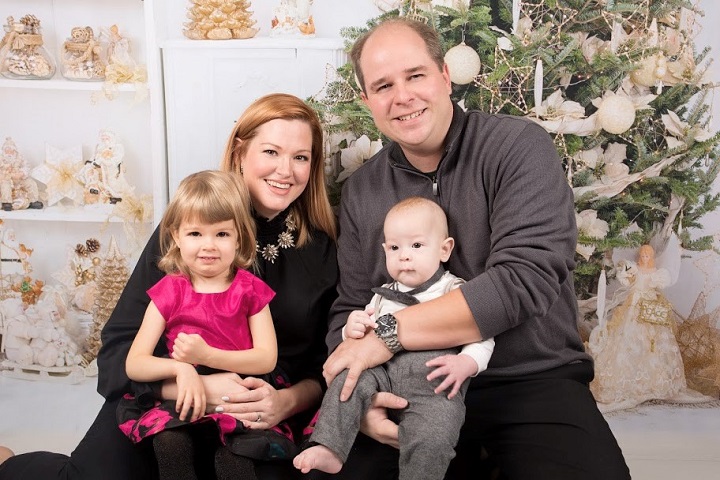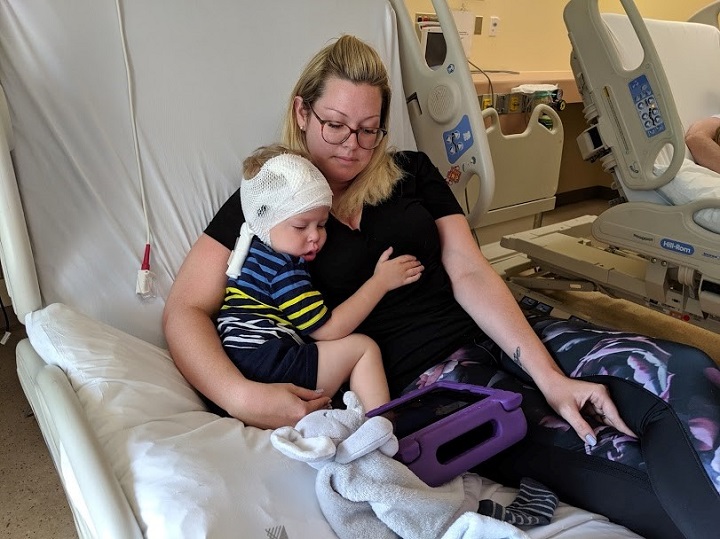On the floor in the living room of their Woodbridge home and surrounded by toys, Terri and Mark Gortnar play with their two young children.

Terri offers four-year-old daughter Claire her baby doll, but she does not reach for it. Meanwhile, two-year-old Josef plays happily with his bright red farm, easily placing the plastic animals in their places.
“He’s running around doing all this stuff and she can’t,” said Mark.
“We find that she’s getting increasingly frustrated because she wants to — and she used to be able to — but she can’t anymore, and that’s gut wrenching.”
READ MORE: Saskatchewan community rallies for 4-year-old with rare disease
Claire is fighting a rare, deadly disease. She is one of around 15 in Canada with CLN2 Batten disease. Batten disease is an inherited nervous system disorder. No specific treatment is available to cure it, but treatments exist to manage the symptoms. Over time, Batten disease damages the brain and nervous system.
“It’s anywhere from 2 to 7 per 100-thousand kids that might be affected,” explained Dr. Lennox Huang, Chief Medical Officer at the Hospital for Sick Children in Toronto. “We have less than a handful of kids with this disease so it’s unbelievably rare.”
Sadly, Claire is not alone in her battle. While he is asymptomatic right now, younger brother Josef has Batten too.
“It’s almost like ALS and MS and dementia all in one,” said Terri as tears fill her eyes.
In Claire, the symptoms are obvious. On the floor in the living room as she tries to stand up, she falls toward her father as her little body trembles.

“She’ll lose her ability to see and she will lose her ability to talk, she will lose her ability to walk, and she will get dementia-like symptoms and maybe not recognize us … then she would pass away,” explained Terri, adding those affected generally do not live beyond 10 years old.
“Seeing what this disease is taking from her, it’s just not fair. She’s not walking on her own, she’s not eating on her own and she’s not toilet trained — it’s almost like having a newborn in the home.”
“This is a disease where you start to lose certain abilities … it just takes one after another away from you until the point where you die at a very early age,” Dr. Huang said, noting most children with Batten die between the ages of 6 and 12.

Get weekly health news
Until Claire’s third birthday, everything appeared normal in the Gortnar home.
“She came out healthy and she was such an easy baby. So we were like, ‘OK, we could totally do number two.’ And then we found out it was a boy — we were just so happy,” recalled Terri.
“I just felt very, very content with these two kids.”
It was not until Claire started missing milestones, like walking, that the parents realized something appeared off. A visit to the pediatrician resulted in an appointment with a neurologist, but the family never made it there.
“I was just after her third birthday (when) she had a seizure, and that’s when everything changed,” said Terri, pausing to reflect back.
“Absolutely terrifying … she was completely unresponsive,” said Mark.
“(She) was just completely out of it and we just panicked. I didn’t know what to do, and it was a gut wrenching moment.”
A CT scan came back normal and the couple said they were reassured by doctors that it was only one seizure. But a few weeks later, they said she had another one and then a third.
“What is actually going on? Is it just childhood epilepsy? Will this pass? Will it not? You start Googling, you start researching, you drive yourself crazy,” recalled Mark.
Claire was put on various different medications and nothing appeared to work.
“At some point she was having 75 drop seizures a day. She wasn’t functioning,” said Terri.
“The meds were making her so sedated that she was just a zombie.”
The couple pushed for genetic testing to be done. Six weeks later, they sat down with a neurologist at Sick Kids Hospital in Toronto. It’s a day they said that remains ingrained in their minds.
“I’ll never forget it. (On) January 15th, we go down for our usual meet-and-greet and discussions at SickKids and they give us the devastating news,” said Mark.
“We were devastated, heartbroken, gutted. We wanted to be sick right there in the room.”
In that conversation, the Gortnars said they were told their younger son Josef, only a year old at that point, had a 25 per cent chance of also having the disease.
“It’s one thing to hear the news about one child, to hear that there’s the possibility of both is devastating,” said Mark.
“This is a deck of cards no one should be dealt.”
Once the couple learned both their children were affected by Batten disease, they said they discovered there is an enzyme replacement therapy called Brineura that could help. They said the treatment is a lifeline until a cure can be found. It replaces the enzymes that their bodies do not make on their own and stops the regression.
The children now receive treatment every two weeks through a device placed in the head.
“Even though this treatment doesn’t cure them by any means, it does slow it down,” explained Terri.
“We can only hope that it slows it down enough that when this gene therapy comes or the next research comes… they have a chance.”
As Dr. Huang explains, “the specific problem that these children have is coded in their genes.. if we can target that exact area and fix it, bring it back to new, then maybe we can stop the disease altogether and cure it.”
The family is intent on raising awareness about Batten disease. The Gortnars launched a website to seek support. Donations help cover the healthcare expenses not covered by insurance or government agencies, such as equipment and therapy, travel, adjustments at home and respite care.
The website noted the Gortnars hope to one day start a foundation “and be able to make a bigger impact in the rare disease world.” But for now, the family said they are keeping the children busy.
“Anything and everything that is going to keep them motivated and keep their brain stimulated and keep their bodies active,” said Mark.
Claire is in speech therapy, horse therapy, music therapy and occupational therapy.
“Gene therapy is the cure — the way to get our kids off treatment, to have our kids have the best shot of life,” said Mark.
Nestled together on the floor of their living room, the children are growing tired. Being awake for a few hours took a toll on Claire. Walking just a few steps holding her mother’s hands is exhausting. Her little brother became sleepy too.
As Claire went for a nap, Josef snuggled into his mother’s lap — his head rested on her chest. These moments are precious to the Gortnars.










Comments